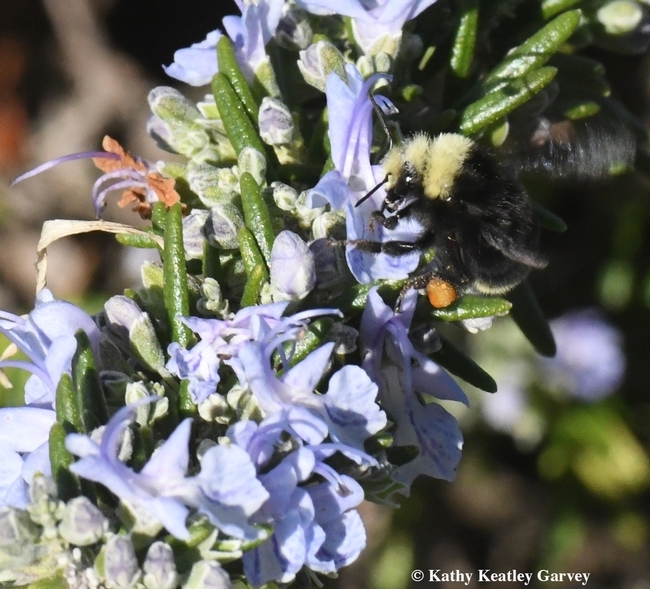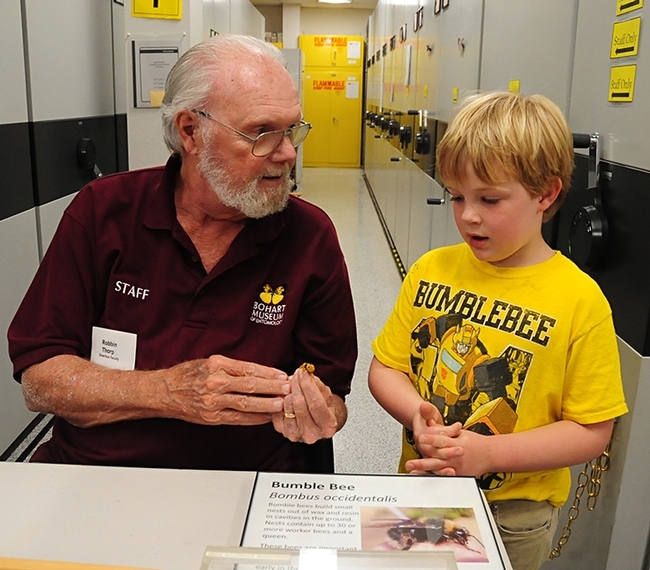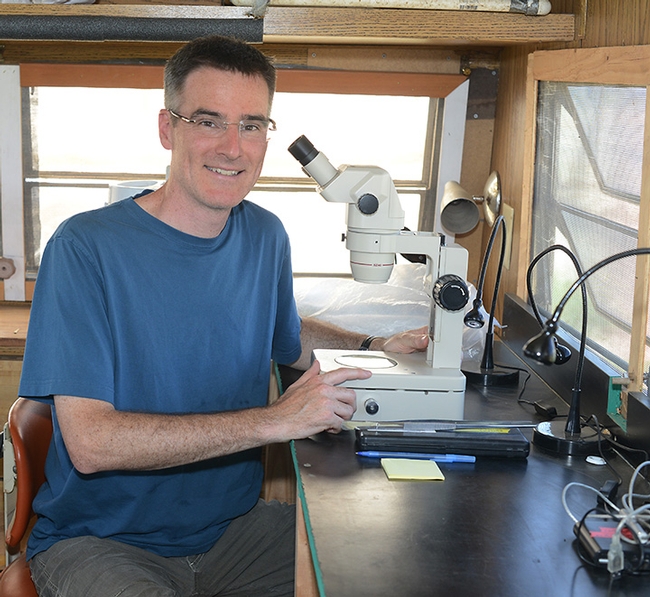- Author: Kathy Keatley Garvey
The highly respected California Academy of Sciences greeted its 2019 Class of Fellows on Oct. 15, and one of them is a pollination ecologist from the University of California, Davis.
Professor Neal Williams of the UC Davis Department of Entomology and Nematology was inducted into the scientific organization at the annual Bay Area gathering of the Fellows. The group includes more than 450 distinguished scientists who have made notable contributions to science.
Dermatologist and associate professor Emanual Michael Maverakis of UC Davis Health was among the 13 other Fellows. (See list of 2019 inductees)
Fellows nominate others for the high honor, and then the California Academy of Sciences' Board of Trustees votes on the nominees. James R. Carey, distinguished professor of entomology, nominated Williams, with Claire Kremen of the University of British Columbia, formerly of UC Berkeley, seconding the nomination. Maverakis was nominated by Walter Leal, distinguished professor, UC Davis Department of Molecular and Cellular Biology, and a former chair of the entomology department.
In his letter of nomination, Carey wrote that Williams is “widely known and respected for his excellence in research, extension, outreach, teaching and leadership” and “is not only one of the stars of our campus, and the UC system, but is an internationally recognized leader in pollination and bee biology and strong voice in the development of collaborative research on insect ecology. He has organized national and international conferences, leads scores of working groups, and guides reviews of impacts of land use and other global change drivers on insects and the ecosystem services they provide.”
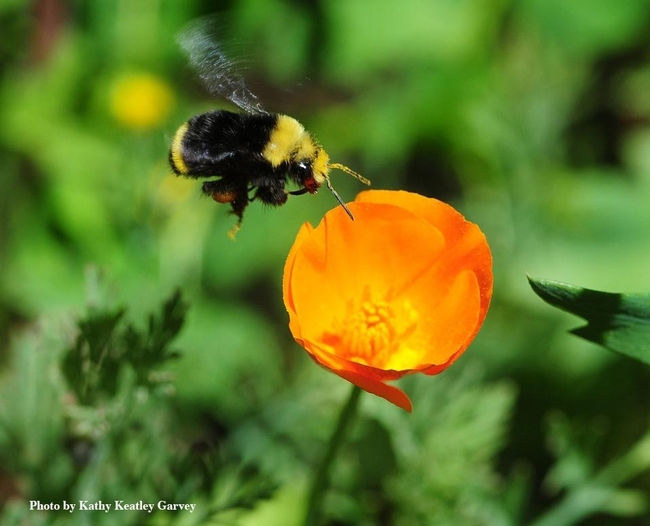
The UC Davis professor served as co-chair (with Extension apiclturist Elina Lastro Niño) of the seventh annual International Pollinator Conference, a four-day conference held July 17-20 on the UC Davis campus. The global conference focused on pollinator biology health and policy.
In his work--a labor of love--Williams seeks and finds found common solutions for sustaining both wild and managed bees and communicates that information to the public and stakeholder groups. Said Carey: “This is a critical perspective in natural and agricultural lands, but also in urban landscapes in northern and southern California.”
Each year the UC Davis professor speaks to multiple beekeeper, farmer and gardener groups, and provides guidance to governing bodies, including the state legislature, and environmental groups. He and his lab are involved in a newly initiated California Bombus assessment project, which is using both museum and citizen scientist records to understand past, current and future distributions and habitat use by bumble bees. This program will host a series of workshops this spring and summer open to practitioners and the public.
Williams received his doctorate in ecology and evolution in 1999 from the State University of New York, Stony Brook and served as an assistant professor in the Department of Biology at Bryn Mawr (Penn.) College from 2004 to 2009. He joined the UC Davis faculty in 2009, advancing to full professor in 2017.
His honors and awards are numerous. Williams was part of the UC Davis Bee Team that won the Team Research Award from the Pacific Branch, Entomological Society of America (PBESA) in 2013. In 2015, he was named a five-year Chancellor's Fellow, receiving $25,000 to support his research, teaching and public service activities. And then earlier this year, Williams received PBESA's Plant-Insect Ecosystems Award, presented annually for outstanding accomplishments in the study of insect interrelationships with plants.
In addition to Carey, five others affiliated with UC Davis Department of Entomology and Nematology are Fellows of the California Academy of Sciences:
- Professor Phil Ward, ant specialist
- Frank Zalom, integrated pest management specialist and distinguished professor of entomology. He is a past president of the Entomological Society of America
- Robert E. Page Jr., bee scientist and UC Davis distinguished emeritus professor. He is a former chair of the UC Davis Department of Entomology and provost emeritus of Arizona State University
- Walter Leal, distinguished professor, UC Davis Department of Molecular and Cellular Biology, and a former chair of the entomology department; and
- Visiting scientist Catherine Tauber, formerly of Cornell University.
Former Fellows from the UC Davis entomology department include Robbin Thorp (1933-2019), distinguished emeritus professor of entomology, and visiting scientist Maurice Tauber (1931-2014), formerly of Cornell University.
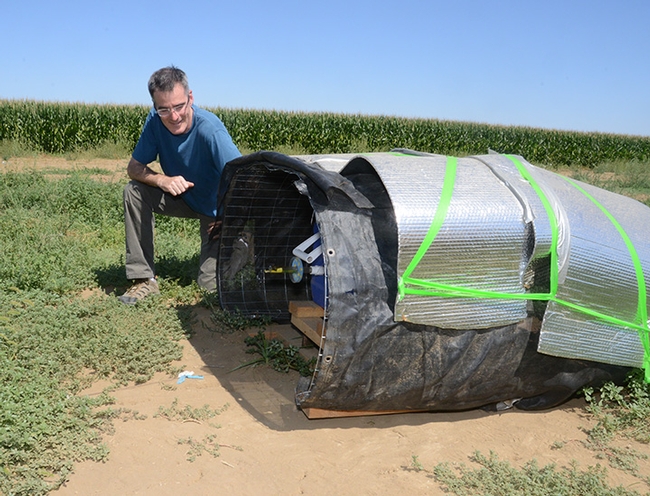
- Author: Kathy Keatley Garvey
Remember receiving valentine cards that read "Bee My Valentine?"
Well, every day can be Valentine's Day when there are bees in your garden.
We captured this image several years ago of a queen bumble bee, Bombus vosnesenskii, nectaring on a spiked floral purple plant, Salvia indigo spires (Salvia farinacea x S. farinacea). She had just emerged from her winter hibernation on a sunny day in November. The site: the Sonoma Cornerstone pollinator garden of Kate Frey. She's the co-author of The Bee-Friendly Garden (with UC San Francisco professor Gretchen LeBuhn), and a world-class garden designer and pollinator advocate.
It wasn't Valentine's Day, but then again, yes, it was!
Every day is Valentine's Day when there are bees in your garden.
Bee my valentine!
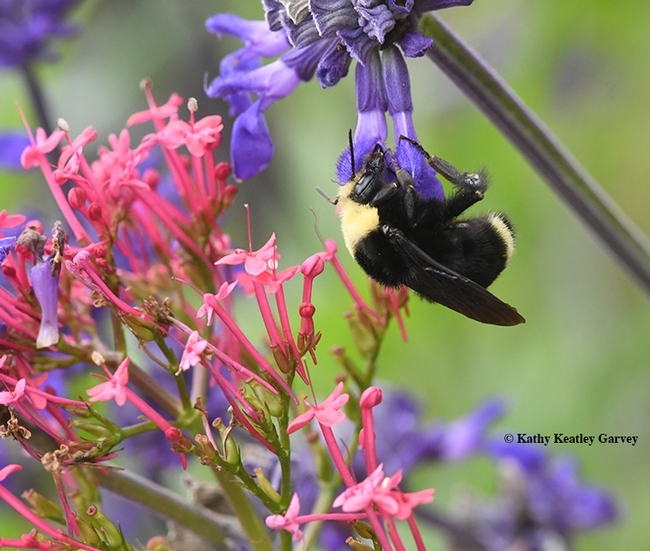
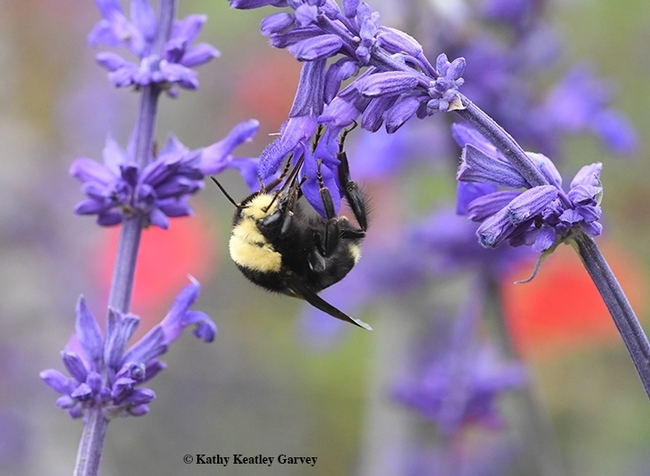
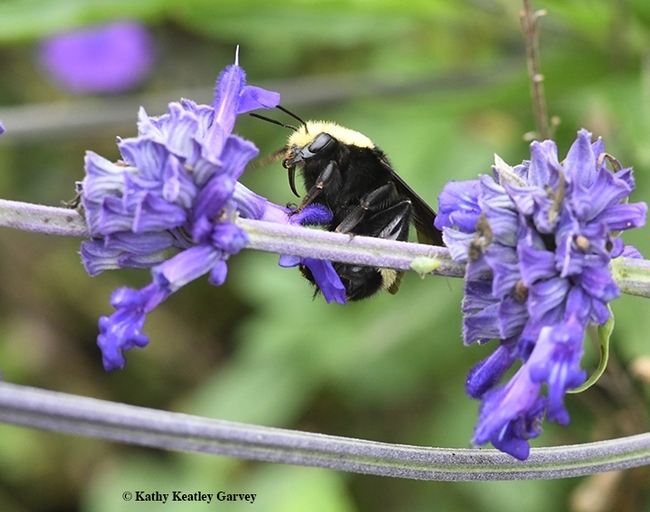
- Author: Kathy Keatley Garvey
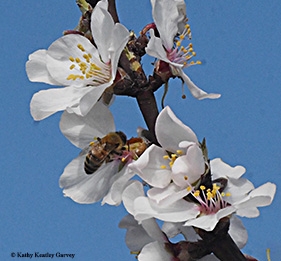
Bumble bees foraging on almond blossoms.
Make that the yellow-faced bumble bees, Bombus vosnesenskii, in Benicia.
Sunday morning as the temperatures soared to 62 degrees in the Matthew Turner Park, Benicia, near the Carquinez Straits, bumble bees competed with honey bees for a share of the golden nectar on the blossoming almond trees.
We witnessed near collisions as lumbering bumble bees lugged incredibly heavy loads while their more streamlined cousins, the honey bees, darted, ducked and dipped to avoid them. Definitely a need for air traffic controllers!
"Bumble bee, bumble bee, cleared for take-off."
"Honey bee, honey bee, stand by."
"Bumble bee, bumble bee, permission to land."
"Honey bee, honey bee, exit runway."
"Bumble bee, bumble bee, line up and wait."
"Honey bee, honey bee, cleared for take-off."
What a sight to see and what a beauty of a day to see bumble bees in Benicia.
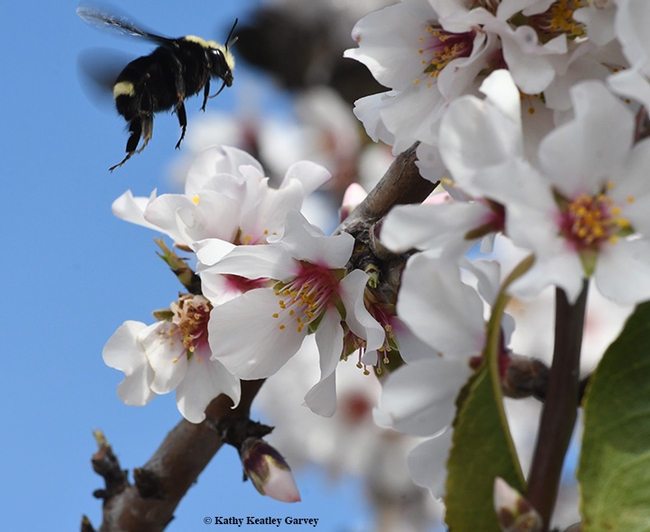
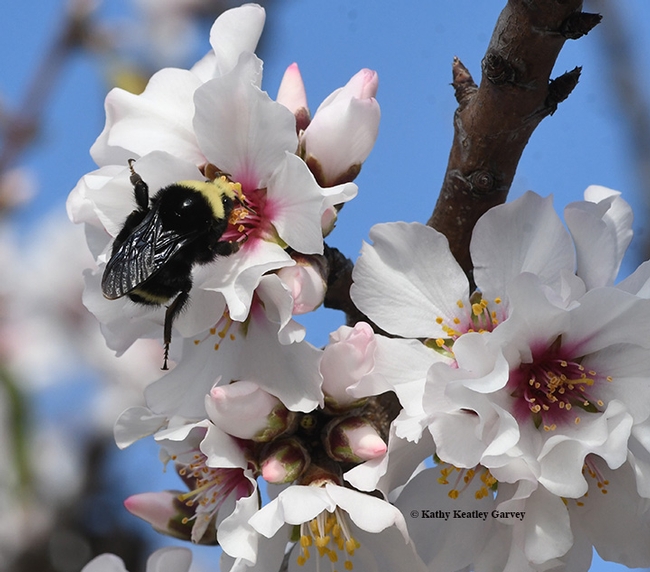
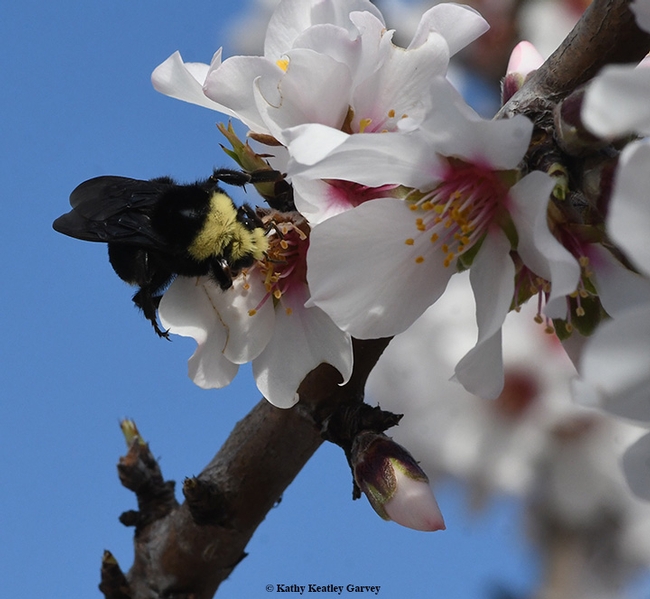
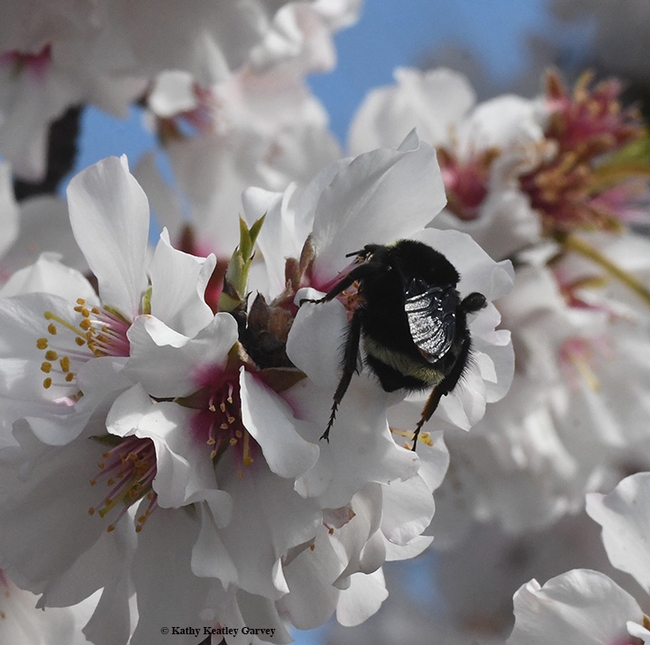
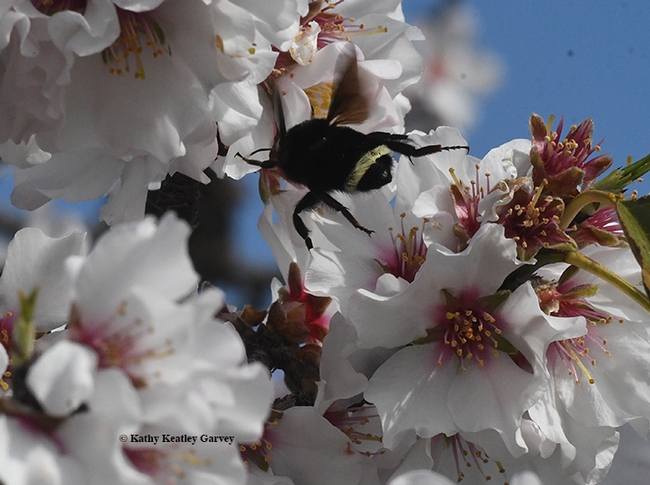
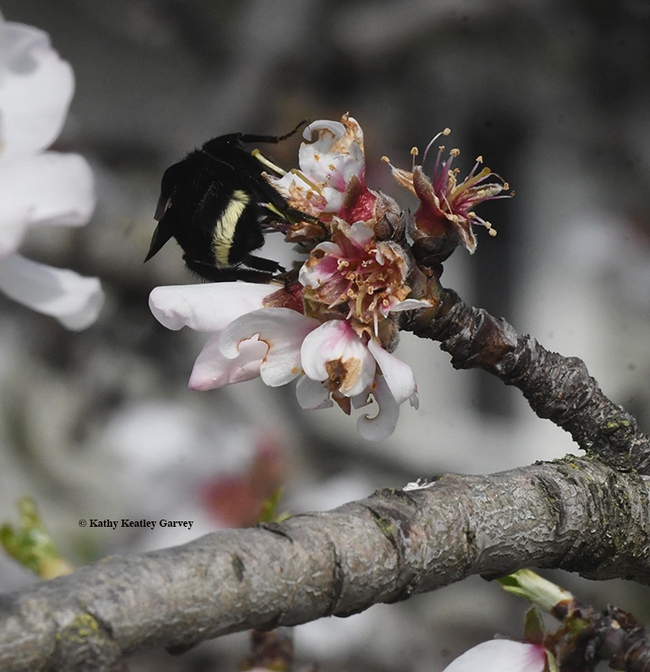
- Author: Kathy Keatley Garvey
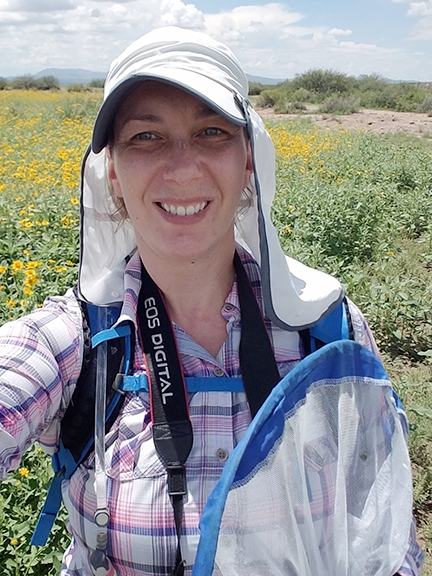
Several UC Davis bumble bee enthusiasts--encouraged by native pollinator specialist Robbin Thorp, UC Davis distinguished emeritus professor of entomology--compete every January to find the first bumble bee of the year in Yolo and Solano counties.
It's a friendly competition. Gamers include Allan Jones, Gary Zamzow, both of Davis, and yours truly.
We have a winner!
Drum roll...
On Thursday, Jan. 10 doctoral student Kim Chacon photographed a black-tailed bumble bee, Bombus melanopygus, on manzanita blossoms in the UC Davis Arboretum and Public Garden.
What a delightful find! And in between the rain drops!
This species is native to western North America, ranging from California to British Columbia and as far east as Idaho. It's commonly found on manzanitas, wild lilacs, wild buckwheats, lupines, penstemons, clovers, and sages, among others.
Chacon actually spotted an earlier bumble bee on Jan. 9 at 2:10 p.m. in the UC Davis Arboreutm, but had only her cell phone with her that day. It was a Bombus melanopygus on Arbutus in the Ericaceae section.
She captured some images with her cell phone, but "there was a big downpour about 15 minutes and I didn't bring my good camera, so I went home for the day. I know from my research that this particular location in the Arboretum is a hot spot for bees. The banks and flowering vegetation get plenty of sun. There are three possible spots in the Arboretum, according to my research, and this one had blooming flowers first."
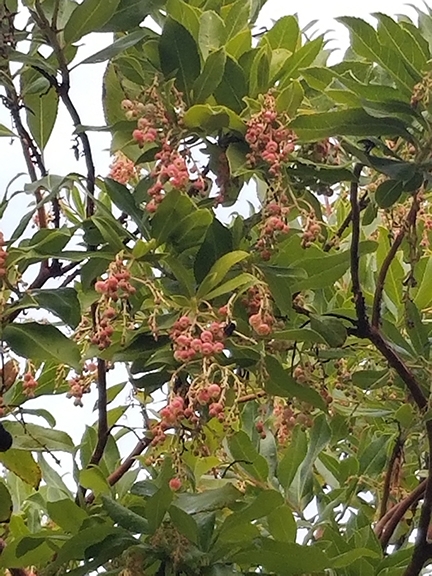
But on Jan. 10, "I woke up determined to get good photos with my good camera!" She walked over to the Ericaceae section again in the Arboretum and spotted a Bombus melanopygus at 3:58 p.m. (See photos below)
Chacon, a UC Davis PhD student in geography, studies "habitat connectivity issues for bees at a landscape scale."
"Lack of habitat connectivity is listed as the main reason for native bee declines and yet, thus far solutions only include stand alone gardens, with randomly spaced unspecified plant species," she commented. "A spatial habitat problem such as destruction and fragmentation needs a spatial solution. I am working on solving this complex problem with the help of Geographic Information Systems (GIS). Part of my research involved weekly monitoring bee visitation of bees throughout the UC Davis Arboretum for one full year. I learned about the trends of bee-flower visitation within each unique themed garden, specifically, how they function as novel ecosystems. When I graduate I hope to design effectively connected landscape habitat for bees. I would also love to design educational gardens, showcasing bee diversity!"
Chacon is a 2018 alumnus of The Bee Course, a nine-day intensive workshop affiliated with the American Museum of Natural History and held annually at the Southwestern Research Station, Portal, Ariz. It's offered for conservation biologists, pollination ecologists, and other biologists who want to gain greater knowledge of the systematics and biology of bees. This year's dates are Aug. 18-28, and the deadline to apply is March 1, 2019.
Thorp is one of the veteran instructors of The Bee Course; he has taught there annually since 2002. A member of the UC Davis entomology faculty from 1964 to 1994 and internationally recognized for his expertise on bees, he achieved "distinguished emeritus professor" status in 2015. He co-authored the UC California book, California Bees and Blooms: A Guide for Gardeners and Naturalists (Heyday) and Bumble Bees of North America: An Identification Guide (Princeton University Press).
Thorp continues his research, writings and bee identification at his office in the Harry H. Laidlaw Jr. Honey Bee Research Facility at UC Davis.
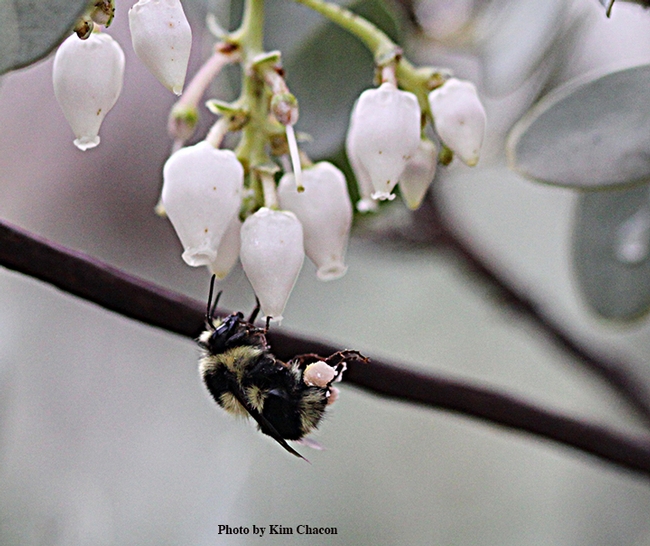
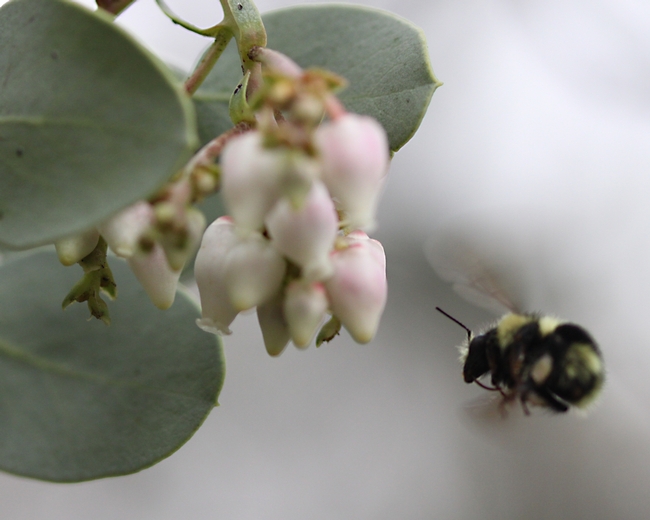
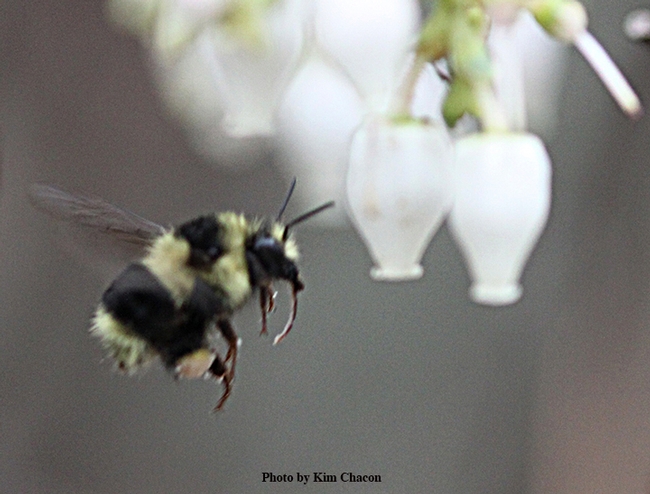
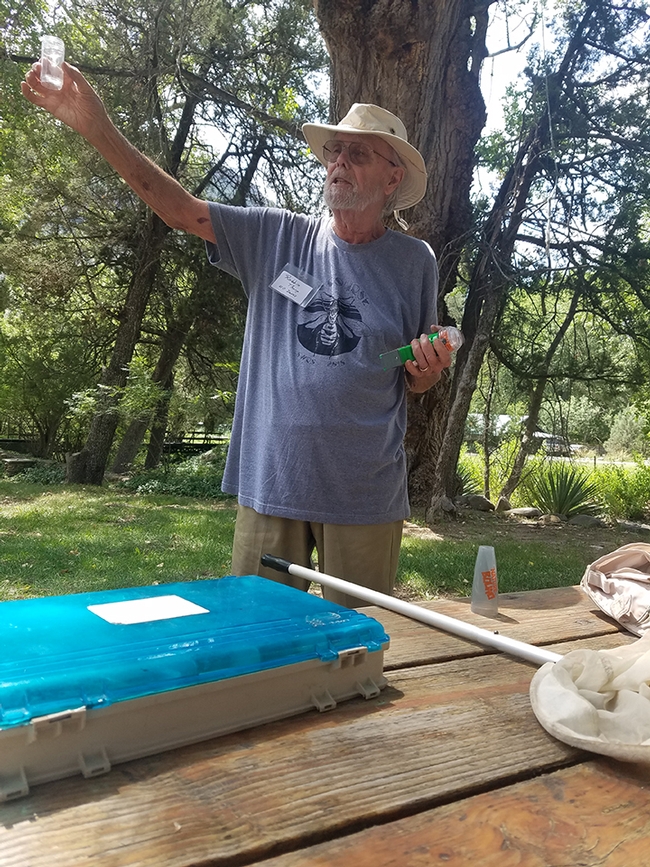
- Author: Kathy Keatley Garvey
It was the morning of Jan. 1, 2018, a year and four days ago.
While strolling the grounds of the Benicia Capitol State Historic Park, we captured images of yellow-faced bumble bees, Bombus vosnesenskii, nectaring on jade, Crassula ovata. They were packing cream-colored pollen from the jade. The same day, we spotted the same species nectaring on rosemary, Rosmarinus officinalis, by the Benicia marina, but packing orange pollen, probably from the nearby California golden poppies.
Thus began our Year of the Insects.
So far this year, we haven't spotted a single bumble bee in Solano or Yolo counties. It's too early in the season (except for hot spots in Benicia, Solano County, where even some almond trees bloom on Jan. 1!)
Nowadays, though, the talk isn't just about "bumble Bees," the insect, but "Bumblebee," the movie, as in the 2018 American science fiction action film. It's about a Transformers' character of the same name, described as "battle-scarred and broken."
Why is the insect spelled "bumble bee," two words? The Entomological Association of America (ESA), in its newsletter, Entomology Today, explains: "...entomologists use two words if a common name accurately describes the order to which a particular insect belongs. For example, all true flies belong to the order Diptera, so true fly names will be spelled using two words by entomologists--house fly, horse fly, pigeon fly, or stable fly, for example. However, despite their names, dragonflies and butterflies are NOT true flies --their orders are Odonata and Lepidoptera, respectively — so they are spelled as one word." (Check out the ESA Comman Names of Insects Database.)
So there you have it: bumble bee, the insect, and Bumblebee, the movie.
And sometimes there's a serendipity moment when the two meet.
We remember back in April of 2017 when native pollinator specialist Robbin Thorp, distinguished emeritus professor of entomology, UC Davis Department of Nematology and Nematology, was displaying bumble bees at a Bohart Museum of Entomology open house.
Thorp, a global authority on bumble bees, is the author of Bumble Bees of North America: an Identification Guide (Princeton University) and California Bees and Blooms: A Guide for Gardeners and Naturalists (Heyday).
So was he ever surprised when in a defining moment, 6-year-old Adne Burruss of Irvine (his mother, Sigrid, is a geneticist and UC Davis alumna) walked up to him wearing a Bumblebee t-shirt. Adne wanted to look at the "other" bumble bees.
So do we! So do we!
